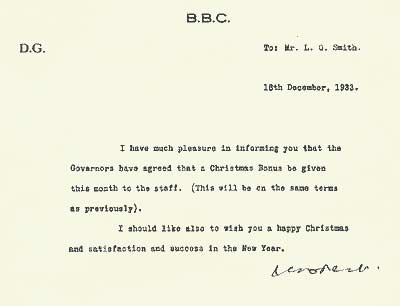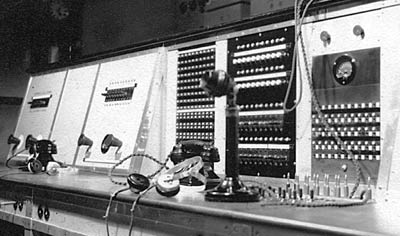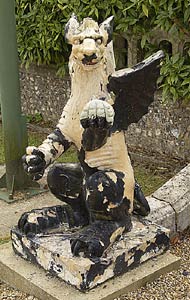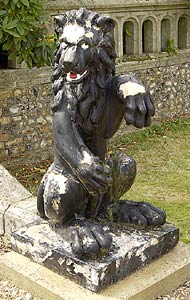
In the early days at Savoy Hill equipment such as amplifiers was provided by Marconi and Western Electric. They were huge units in mahogany boxes about 6ft x 4ft x 2ft. Programmes were routed to transmitters by the shortest available route over the SB (Simultaneous Broadcast) Network. Thus a programme originating in Birmingham would be routed northwards via Manchester, Leeds, Newcastle and Edinburgh for the northern transmitters and southwards via London and Bristol for the Regional transmitters at Brookmans Park and Washford. Continuity Suite working was not introduced until 1940.
Many programmes originated in the Regions for Regional broadcasting but Big Ben and the main news broadcasts originated in London and would be fed via all regional control rooms to the transmitters.
The switching of lines was carried out in all control rooms via plugs and jacks following standard GPO practice and needed accurate timing and monitoring to ensure that all lines were 'over to London' for Big Ben and the news for instance. There never seemed to be any difficulty in this switching throughout the 1930s and I cannot understand why so many video programmes that I try to record have missed beginnings and endings due to early starts and overruns!
Since there was a close relationship between BBC and GPO engineers, a Lines Section of BBC engineers at Savoy Hill under a Mr A. S. Attkins was responsible for the rebuilding of Manchester control room, a main switching centre, to replace the plug and jack switching facilities with Strowger two-motion selectors. The equipment, including amplifiers, was rack-mounted, finished in a GPO grey-green paint and operated from GPO-type mahogany switchboards. Although this type of switching was acceptable for automatic telephone working, the clicks and unreliability were unacceptable for BBC purposes, although it still remained in use until the mid-1930s.
Following this failure a small Designs Section was formed as part of Equipment Department to design the switching equipment and associated amplifiers for Broadcasting House. This section consisted of 'Uncle' Colborn and Mr J. Locke as engineers with two draughtsmen all accommodated in one room at Avenue House.
The first results of this section were the rebuild of Edinburgh control room using relays with platinum-gold-silver contacts for programme switching with the old mahogany desks replaced by the now familiar BBC grey-finished rack-mounted equipment and metal desks.
It was at this time in 1929 that I joined as a junior tracer. Equipment Department was located with Research Department in Avenue House, 87 King's Avenue, Clapham - a former residence of the governor of Brixton Prison, which was within 50 yards of Avenue House.
A small workshop and a stores had been built in the forecourt of the house and a garage held the transport fleet of about eight vehicles, with a hand-operated petrol pump from which one could get petrol for the equivalent, I think, of 12½p a gallon.
The Head of Equipment Department was F.M. Dimmock, father of Sports and OB commentator Peter Dimmock. The only ladies on the staff were Mrs Lewis, who brought round the tea at one old penny a cup, and a part-time cook. These two provided two sittings of lunch in what used to be the lodge of the governor's house. All secretaries, typists and the switchboard operators were male; one of the switchboard operators, Syd Holmes, in later years became Head of Research Department drawing office at Kingswood Warren.
We worked until 6pm and every other Saturday until 1pm. There were no proper salary grading systems, no overtime, extra duty pay or leave in lieu; everyone worked to do a good job and many evening and all-night sessions would be worked to clear faults when testing new installations without thought of time off.
There were 'moans'. A cost of living allowance had been paid to staff working in London at Savoy Hill and within 10 miles of Savoy Hill to cover the many premises in central London. When the headquarters moved from Savoy Hill to Broadcasting House, Avenue House was outside the 10 miles radius and the allowance was ceased.
In the economic depression of the early 1930s a meeting was called by Sir John Reith of all BBC staff in the Concert Hall of BH to consider a contribution by deduction from pay, to open a centre for the unemployed in Gateshead. Equipment Department staff, including workshop staff, came up from Avenue House and a representative from the Ministry of Labour sat on the platform with Sir John to say his piece. After hearing all about the project, suddenly one of the workshop staff got up and said, "Before collecting for the unemployed in Gateshead, what about the workshop staff at Avenue House? I have been working for the BBC for five years and get only 6d an hour," or words to that effect. He was followed by about half a dozen others.
Sir John immediately adjourned the meeting, called for any other complaints, took the names of the workshop staff and arranged to see them all in his office the next morning, before continuing the meeting. As a result many had their wages doubled and all had rises of some sort.

It is difficult to appreciate that in the late 1920s and early 1930s virtually no commercial equipment was available to satisfy the standards required by the BBC. Components such as transformers, resistors, volume controls, etc. were therefore designed and made by ED. Resistors were made by turning slots in 1-inch diameter ebonite road and hand-winding these with resistance wire. Six such resistors about 4 inches long connected to a 24-way stud switch, also made in ED, formed a main volume control.
All components were tested before being incorporated into amplifiers and other apparatus, which were built on 3/16-inch steel panels for rack-mounting. Terminal blocks for these units were of 3/16-inch ebonite, having each soldering tag fixed with a nut and bolt. Wiring inside the units was carried out in 16SWG bare tinned copper wire covered in red sleeving with all the wire running straight with right-angled bends.
As ED expanded to provide for the installations in Broadcasting House followed by the re-equipment of regional premises, an asbestos bungalow was built in the garden of Avenue House. Designs Section occupied a long room across the end of the bungalow, the drawing office expanded to six and two engineers from ST&C skilled in relay circuit design and cableform design assisted 'Uncle' Colborn.
There were lighter moments of course. The head draughtsman, Alan Holden, lived very near Avenue House and as there was plenty of garden available, he started a little allotment outside the drawing office windows, which he cultivated in the evenings. He proudly announced one day that he had planted some runner beans, so in his absence we dug up the beans and planted instead some giant sunflower seeds, which we encouraged Alan to water every evening. When these were about three inches high they looked very similar to runner bean plants and Alan duly erected an array of bean sticks. At nine inches high we persuaded him he had to tie them first clockwise and when they still would not curl round, to try anticlockwise round each bean stick. Alan was not a very knowledgeable gardener and it was not until the sunflower plants were about 2ft high that Alan realised what was going on. We did, however, enjoy a great variety of birds eating the sunflower seeds.
Drawings at that time were drawn in Indian ink on tracing linen. Circuits had resistors drawn as about a dozen zigzags, all lines at the correct angle, and transformers needed about 20 semicircles joined with straight lines to represent the coils. All lettering was hand-done - no stencils or stick-on labels for circuit components.
Tracings then had to be taken to a firm in Kingsway for individual prints to be made, which were in the form of white lines on a bright blue paper - hence the term 'blueprint' used nowadays in the context of any new National Health proposals or whatever. Later these reproductions became dyeline prints - brown lines on white paper, much easier to mark up and revise.
Having learnt something about ED Test Room activities by coming in on my Saturday mornings off-duty, I began working there part-time and then full-time as the workload increased with the equipment requirements for Broadcasting House and later the Regional control rooms. Although it was a long time before I was officially designated an engineer from being a drawing office tracer.
The Test Room was located in what was the old drawing room of the governor's house and judged by today's safety standards, was a lethal place to work. There were two test positions for rack-mounted equipment consisting of bay frameworks with terminal blocks of brass pillar terminals that carried 300V HT, 6V LT and GB voltages all fully live, so it was advisable to keep one hand in your pocket when connecting wires to these. The main 300V HT came from accumulators kept under a bench fed through open knife switches.
Amplifiers were tested for frequency response by switching in a thermocouple from input to output to measure tone from the bay-mounted variable oscillator to a fixed oscillator mounted as far away as possible high up on the other side of the room. Most of the time was taken up by tapping the glass of the thermocouple meter to get as high a reading as possible.
We still enjoyed a few lighter moments, particularly at the expense of one engineer, 'Auntie' Kidd, ex-Research Department, whose responsibility in Test Room was the testing of microphones. He used a large coffin-shaped box, which had the microphone under test at one end and a loudspeaker at the opposite end, into which tone was fed. The box was very heavily soundproofed and the lid fitted with a very large number of screws requiring removal for access. A headphone jack was provided to check that the loudspeaker was working. Time after time the diaphragms were removed from Auntie's headphones, giving him the onerous task of removing the screws and lid to check the loudspeaker. He never seemed to learn.
Broadcasting House came into service in May 1932. The studios were contained in a tower built of blue engineering brick with very few doorways or other openings. This tower was surrounded by corridors and offices constructed as normal over a steel girder framework with no girder connection to the studios; thus these were well insulated from outside acoustic interference and were further insulated vertically by quiet areas such as libraries and storage areas.
The existence of the blue brick tower, which is 4ft thick in the basement, appears to have been overlooked in recent times, as a request for a 6in x 6in cable hole through this at the time of the BH Extension work was dismissed as 'no problem, a few days work'. I seem to remember work was going on several weeks later to make the hole. A fact not generally known about BH is that it has an artesian well, which provides an excellent programme earth.
The Director of Administration at that time was of the opinion that the whole of the BBC revolved around his department. Engineers were but glorified plumbers who should be confined to the basement and the eighth floor. He supervised the six pageboys, who sat in the entrance hall to run errands, and he stood about in black jacket and pinstriped trousers, wearing a monocle. The story was told that one day he sent a new monocle to a small workshop attached to the eighth floor to have it drilled for its black ribbon. As he did not specify where it was to be drilled, it was returned to him with a single hole in the middle of the glass. Not a person popular in the Engineering Division.
Re-equipment of the Regional Control Rooms proceeded after Broadcasting House and I was very involved in this work. Newcastle, where the BBC had occupied what had previously been a maternity lying-in hospital, was another building where the thick granite walls caused problems, this time for the GPO in routing cables into the new control room. Cardiff was done in June 1934, where the BBC was located in an old house in Park Place, followed by Glasgow, where the studios and Control used an old house in Blythswood Square.

Two control positions and the SB position at Birmingham,
mid-1930s
The chargehand wireman, one Freddie Mott, was an elderly man, very unobtrusive but a superb wireman. Every wire to a jackfield, etc., curled to exactly the same curve with a buttonhook, interbay cables laced, covered with insulating tape and finally finished with yellow empire cloth tape and never, ever, a wrong connection or a dry joint. All wiring was carried out in lead-covered 1pr/10. No multicore cables were used for programme wiring in studios or control rooms until 1940.
It was thought that Freddie Mott should write progress reports to confirm the need for an engineer's visit but his first report caused some amusement when received at ED. It read, "Dear Mr Dimmock, the boys' colds are much better. F. Mott."
The testing and setting to work of these control rooms with their relay switching systems was an intensive period of extra hours of work. Very little was known of the causes and cures of clicks and crosstalk or of the principles of earthing and shielding from interference. All was the subject of much discussion and experiment since the BBC requirements were much more stringent than those of the GPO for their automatic telephone exchanges, and it is thanks to the insistence on these high standards that the BBC enjoyed such a high reputation at that time amongst the broadcasting authorities of the world.
There were no small diodes and suchlike to incorporate in the wiring and no electrolytic condensers. The 'standard' anticlick device was a 2mF condenser (about 2in x 2in x 1in) in a tin case in series with a 600-ohm works-wound resistance wired across the coil of a relay and finding space and mechanical mounting for these or the 25mF condenser about 6in x 3in x 8in was always a problem.
As in the Test Room, 300V HT was fed through open knife switches and open terminal blocks. Each individual unit supply was routed via a small glass fuse, one of 24 similar fuses closely spaced and completely uncovered. Removing or replacing a fuse required very careful holding of the glass between thumb and forefinger without touching the end caps. Sometime later insulated pliers were made available for this task but I never saw any.
Both Research and Equipment Department expanded and outgrew existing accommodation. Research Department moved first to Nightingale Lane and then to Nightingale Square in Clapham, whilst an extra building was built on the Avenue House site. This was mainly a single-storey block, which housed Test Room, battery charging rooms and additional stores areas, with a second storey at one end of the building for Designs Section engineers and the drawing office.
The Test Room had several small rooms for microphone and loudspeaker testing, and the drawing office had nice large windows for the draughtsmen. The only minor faults in the design were the omission of any stairs to get to the second storey of the building and some problems with a patent parquet floor in the test room.
The stairs were fortunately able to be fitted in before final completion, although unfortunately they were not wide enough to take the drawing office plan chests. The test room floor was more serious and its fault came to light after we moved in. Every time anyone touched a 300V terminal a shock was received and this was traced to the floor made of wooden blocks set in a 'muckite' of sawdust, which had a resistance of only a few thousand ohms. This fault was got over by providing each engineer with a rubber mat to stand on when connecting up HT terminals.


When Avenue House moved to Chiswick the beasties were moved there and put inside the entrance hall, at the foot of the stairs. They were later moved outside and later still took up residence at Kingswood Warren, where the pictures were taken. Perhaps a modern-day Bill Pickett will restore them to their former glory.....

